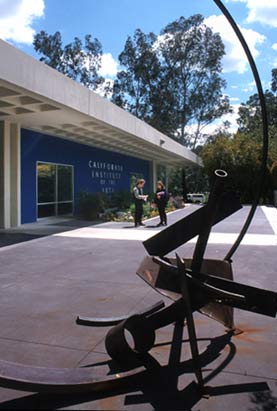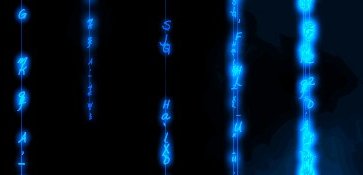
Cal Arts: Valencia, California, U.S.A.
Cal Arts is easily one of the best art schools in the world. It is very strong in traditional 2D character animation, but is not very oriented towards visual effects or computer graphics. Its character animation and experimental animation departments concentrate on core animation skills rather than just the technology. After graduation, most wishing to go into 3D animation will obtain a certificate from a computer animation specialty school, usually going with a course that takes no longer than one year.
From the CalArts website:
From the CalArts website:


About Cal Arts:
California Institute of the Arts educates professional artists in a unique learning environment founded on the principles of artmaking excellence, experimentation, critical reflection and independent inquiry.
Throughout its history, CalArts has sought to advance the practice of art and promote its understanding in a broad social, cultural and historical context. CalArts offers students the knowledge and expertise of leading professional artists and scholars and a full complement of artmaking tools. In return, it asks for the highest artistic and academic achievement. Reflecting its longstanding commitment to new forms and expressions in art, CalArts invites creative risk-taking and urges active collaboration and exchange among artists, artistic disciplines and cultural traditions.
The Cal Arts Campus:
California Institute of the Arts educates professional artists in a unique learning environment founded on the principles of artmaking excellence, experimentation, critical reflection and independent inquiry.
Throughout its history, CalArts has sought to advance the practice of art and promote its understanding in a broad social, cultural and historical context. CalArts offers students the knowledge and expertise of leading professional artists and scholars and a full complement of artmaking tools. In return, it asks for the highest artistic and academic achievement. Reflecting its longstanding commitment to new forms and expressions in art, CalArts invites creative risk-taking and urges active collaboration and exchange among artists, artistic disciplines and cultural traditions.
The Cal Arts Campus:
About The Bachelors And Masters Of Fine Arts Programs At Cal Arts:
The four year, 120 unit Bachelor of Fine Arts and Certificate of Fine Arts programs require a minimum of one year full-time study. The 60 unit Master of Fine Arts and Advanced Certificate of Fine Arts require a minimum of two years full-time study.
Art Program Requirements
Bachelor of Fine Arts and Certificate of Fine Arts:
First Year
AR101A&B Foundation Seminar
AH010 What Makes It Art?
At least two classes from the following:
AR200A Drawing
AR200B Practical Painting
AR200C Sculpture
AR200D Alternative Practices
AR200E Time Based Studio
AR200F Print & Digital Media
AR200G Mac for Artists
Two workshops during the Practicum and one Independent Study (AR800) during Spring semester.
Second Year
AR215A&B Post Foundation Seminar and Critique
At least two classes from the following:
AR200A Drawing
AR200B Practical Painting
AR200C Sculpture
AR200D Alternative Practices
AR200E Time Based Studio
AR200F Print & Digital Media
AR200G Mac for Artists
AR200H Expansive Fields
Two workshops during the Practicum and at least one Independent Study (AR800) each semester.
Both sections of Modern Art History in Review (AH020A&B) must be completed during second or third year.
Third Year
Two workshops during the Practicum and at least one Independent Study (AR800) each semester.
Fourth Year
A final thesis project or exhibition is required, details to be approved by the mentor
Two workshops during the Practicum and at least one Independent Study (AR800) each semester.
Master of Fine Arts and Advanced Certificate of Fine Arts
Each student will fashion a course of study in consultation with the mentor. There is an expectation that a student will present a project or exhibition during the first year. In the final two semesters of residency, the student is required to participate in a two-semester independent study sequence (AR950A&B) in order to prepare for a final exhibition or project.
AR900 Graduate Independent Study
AR950A&B Graduate Independent Study (as preparation for MFA project)
The four year, 120 unit Bachelor of Fine Arts and Certificate of Fine Arts programs require a minimum of one year full-time study. The 60 unit Master of Fine Arts and Advanced Certificate of Fine Arts require a minimum of two years full-time study.
Art Program Requirements
Bachelor of Fine Arts and Certificate of Fine Arts:
First Year
AR101A&B Foundation Seminar
AH010 What Makes It Art?
At least two classes from the following:
AR200A Drawing
AR200B Practical Painting
AR200C Sculpture
AR200D Alternative Practices
AR200E Time Based Studio
AR200F Print & Digital Media
AR200G Mac for Artists
Two workshops during the Practicum and one Independent Study (AR800) during Spring semester.
Second Year
AR215A&B Post Foundation Seminar and Critique
At least two classes from the following:
AR200A Drawing
AR200B Practical Painting
AR200C Sculpture
AR200D Alternative Practices
AR200E Time Based Studio
AR200F Print & Digital Media
AR200G Mac for Artists
AR200H Expansive Fields
Two workshops during the Practicum and at least one Independent Study (AR800) each semester.
Both sections of Modern Art History in Review (AH020A&B) must be completed during second or third year.
Third Year
Two workshops during the Practicum and at least one Independent Study (AR800) each semester.
Fourth Year
A final thesis project or exhibition is required, details to be approved by the mentor
Two workshops during the Practicum and at least one Independent Study (AR800) each semester.
Master of Fine Arts and Advanced Certificate of Fine Arts
Each student will fashion a course of study in consultation with the mentor. There is an expectation that a student will present a project or exhibition during the first year. In the final two semesters of residency, the student is required to participate in a two-semester independent study sequence (AR950A&B) in order to prepare for a final exhibition or project.
AR900 Graduate Independent Study
AR950A&B Graduate Independent Study (as preparation for MFA project)
About The Cal Arts Film And Video Program:
Required Courses for Undergraduate Students
BFA-1 (and 1st Year Transfer Students)
F 101 Filmmaking Fundamentals (Fall)
F 126* Video Production Workshop (Fall)
CS175A&B Film History (Fall and Spring)
F 153A&B Structuring Strategies/Artist Presentations (Fall and Spring)
F 134* Digital Editing: Final Cut Pro Workshop (Fall)
BFA-2 (and 2nd Year Transfer Students)
F 108A&B Undergraduate Film Production Workshop (Fall and Spring)
F 103 Cinematography (Fall)
F 185* Production Sound for PFV & FDP (Fall)
F 381* Post-Production Sound (Spring)
*Satisfactory completion of these classes is a prerequisite to individual access to equipment
and use of facilities for independent projects.
BFA-3 and BFA-4
Undergraduate students are required to take Undergraduate Critique (F 340) for at least 2 semesters during their final 2 years of residence. During these final two years, undergraduate students are expected to either produce a senior project or contribute substantially to a
number of student projects in one of the following capacities: cinematography, editing, production or sound design.
Incoming Undergraduate Students are required to take both semesters of Film History (CS175A&B). Students who enter as BFA-1 are required to complete 3 years of film/video history, theory or criticism courses. Transfer students are required to complete 2 years of
film/video history, theory, or criticism courses. A list of classes that satisfy this requirement is available at registration each semester.
Undergraduate Students are required to take at least one Visiting Artists Workshop during their 3rd or 4th year.
Required Courses for Incoming Graduate Students:
F 501 Filmmaking Fundamentals (Fall)
F 103 Cinematography (Fall)
F 126* Video Production Workshop (Fall)
F 134* Digital Editing: Final Cut Pro Workshop (Fall)
F 104A&B* Film Production Workshop (Fall and Spring)
F 185* Production Sound for PFV & FDP (Fall)
F 381 Post-Production Sound (Spring)
CS175A&B Film History (Fall or Spring)
F 153A&B Structuring Strategies/Artists Presentations (Fall and Spring)
*Satisfactory completion of these classes are a prerequisite to individual access to equipment and use of facilities for independent projects.
Required Courses for Undergraduate Students
BFA-1 (and 1st Year Transfer Students)
F 101 Filmmaking Fundamentals (Fall)
F 126* Video Production Workshop (Fall)
CS175A&B Film History (Fall and Spring)
F 153A&B Structuring Strategies/Artist Presentations (Fall and Spring)
F 134* Digital Editing: Final Cut Pro Workshop (Fall)
BFA-2 (and 2nd Year Transfer Students)
F 108A&B Undergraduate Film Production Workshop (Fall and Spring)
F 103 Cinematography (Fall)
F 185* Production Sound for PFV & FDP (Fall)
F 381* Post-Production Sound (Spring)
*Satisfactory completion of these classes is a prerequisite to individual access to equipment
and use of facilities for independent projects.
BFA-3 and BFA-4
Undergraduate students are required to take Undergraduate Critique (F 340) for at least 2 semesters during their final 2 years of residence. During these final two years, undergraduate students are expected to either produce a senior project or contribute substantially to a
number of student projects in one of the following capacities: cinematography, editing, production or sound design.
Incoming Undergraduate Students are required to take both semesters of Film History (CS175A&B). Students who enter as BFA-1 are required to complete 3 years of film/video history, theory or criticism courses. Transfer students are required to complete 2 years of
film/video history, theory, or criticism courses. A list of classes that satisfy this requirement is available at registration each semester.
Undergraduate Students are required to take at least one Visiting Artists Workshop during their 3rd or 4th year.
Required Courses for Incoming Graduate Students:
F 501 Filmmaking Fundamentals (Fall)
F 103 Cinematography (Fall)
F 126* Video Production Workshop (Fall)
F 134* Digital Editing: Final Cut Pro Workshop (Fall)
F 104A&B* Film Production Workshop (Fall and Spring)
F 185* Production Sound for PFV & FDP (Fall)
F 381 Post-Production Sound (Spring)
CS175A&B Film History (Fall or Spring)
F 153A&B Structuring Strategies/Artists Presentations (Fall and Spring)
*Satisfactory completion of these classes are a prerequisite to individual access to equipment and use of facilities for independent projects.
California Institute of the Arts
24700 McBean Parkway
Valencia, California, USA
91355-2379
1-661-255-1050
24700 McBean Parkway
Valencia, California, USA
91355-2379
1-661-255-1050
For More Information On Cal Arts, See:
http://www.calarts.edu/
http://www.calarts.edu/

Find A Design, Art Or Animation School:

The center of campus life is a sprawling five-level, 500,000-square-foot building, where, according to Walt Disney's original vision for CalArts, different artistic disciplines share space under one roof. This structure houses classrooms, art studios, animation studios, music rehearsal rooms and dance studios; galleries, theaters for drama, dance and film, and a music hall; costume, scenery and machine shops; photo labs, computer and media labs, editing suites for film and video, and a digital recording studio; a library and a cafeteria.
Back To: Art/Media Schools, All
Animation Schools | Free Animations | Animation Freeware & Shareware | Animation Top 10's | Fun Art Quizzes | Build A Website | Web Design Software

Animation Schools | Free Animations | Animation Freeware & Shareware | Animation Top 10's | Art Quizzes | Build A Website | Web Design Software
Contact | Sitemap | Privacy Policy | Article Archive
Copyright 2006-2008 Build A Website
Contact | Sitemap | Privacy Policy | Article Archive
Copyright 2006-2008 Build A Website